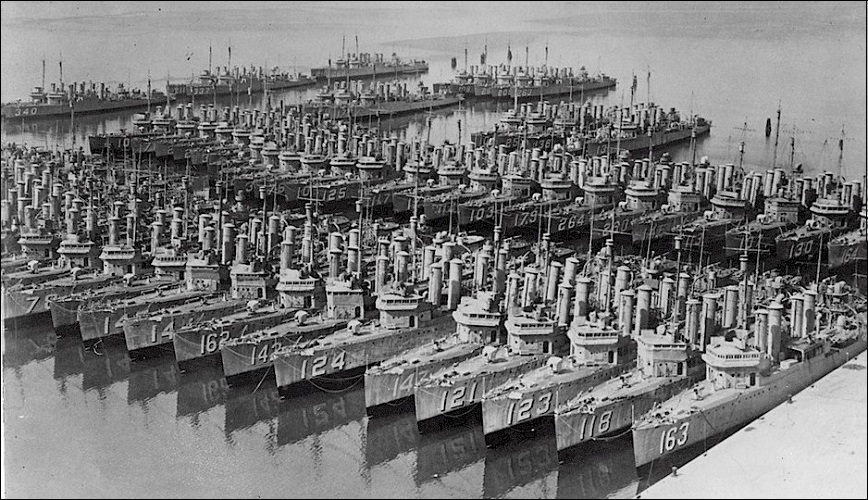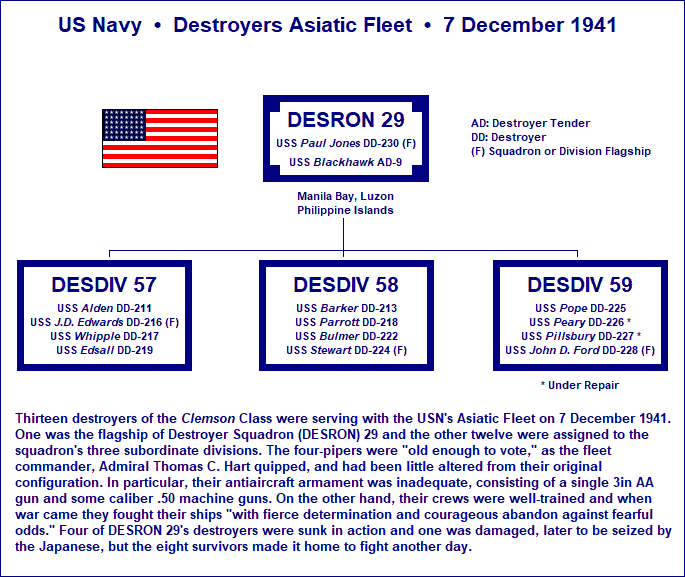The following
abbreviations are used in this article: AA (antiaircraft
gun), DC (depth charge), DP (dual purpose
surface/antiaircraft gun), HA (high-angle antiaircraft gun),
HMS (His Majesty's Ship), TT (torpedo tubes), USS (United
States Ship). Relevant USN hull type codes were DD
(destroyer), DM (destroyer minelayer) DMS (destroyer
minesweeper), ADP (fast transport) and AVP (light seaplane
tender).
● ● ●
The US Navy’s first true
destroyers—seagoing flotilla craft whose main armament was
the torpedo—were the five ships of the
“Smith” class, which
entered service around 1910. They represented a great
advance over earlier classes, some of which though rated
as destroyers were no more than lightly armed seagoing torpedo boats. The
"Smiths" were much larger, with a uniform armament of 5 x
3in guns plus 3 x 18in TT (single mounts; exchanged for 3 x
twin mounts in 1916.) The basic
“Smith” design with
detail improvements was used for the next two classes,
totaling twenty-one ships. Then came the four ships of the
“Cassin” class, the
first of the so-called thousand-tonners. These ships were
larger and faster than their immediate predecessors, with a
heavier armament: 4 x 4in guns and 8 x 18in TT (2 x
quadruple mounts). This progressive increase in destroyer
size and firepower reflected the Navy’s growing concern with
the creation of an integrated battle fleet. For that purpose
destroyers had to be robust and seaworthy, with a longer
range than hitherto. The
“Cassin” class was repeated with detail improvements
in the next two classes, totaling twelve ships. Thus by 1917
the Navy possessed a force of 44 reasonably modern
destroyers.
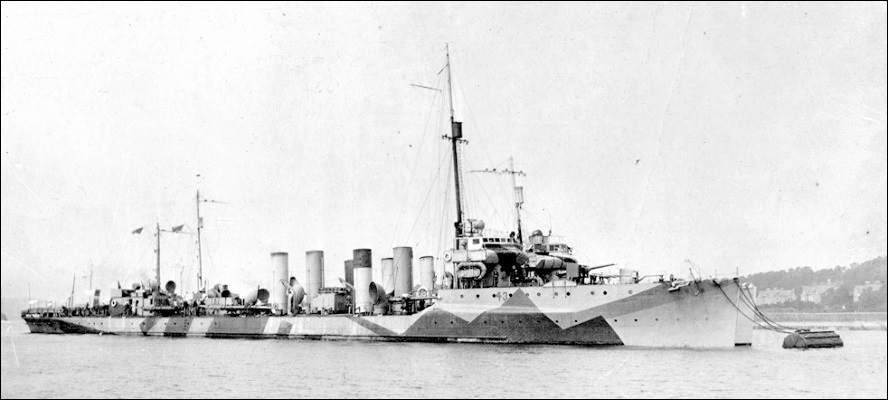
USS Cassin (DD-43)
with a sister ship at Queenstown, Ireland in 1918 (Naval
Heritage & History Command)
The outbreak of World War I and the
increasing likelihood that the United States would become
involved in it led to congressional passage of the Navy Act
of 1916: a massive three-year construction program intended
to create “a Navy second to none.” In addition to new
battleships, battle cruisers and cruisers, the Act provided
for 50 new fleet destroyers. This was the genesis of the
Navy’s enormous wartime destroyer construction program that
ultimately produced 267 ships: the famous four-pipers of the
'Wickes" and "Clemson" classes—so called because
of their four evenly spaced funnels.
The six ships of the "Caldwell"
class served as prototypes for the mass-produced
four-pipers. Though much the same size as their
predecessors, they were fractionally faster and mounted a
heavier torpedo armament: 12 x 21in TT ( 4 x triple mounts,
two on each broadside). Otherwise, their armament was the
same as the preceding "Sampson" class: 4 x 4in guns plus 2 x
1-pounder AA guns. Visually, they were distinguished from
earlier classes by their flush deck (no forecastle break)
and their more extensive bridgework.
To keep down weight, the
“Caldwells” were designed with a flush deck, relatively shallow draft, a cruiser
stern, and a “drag” (keel sloping aft) to ensure that the
propellers and rudder were sufficiently deep in the water.
This made them wet forward and it was also found that they
had an undesirably large turning circle. The mass-produced
four-pipers therefore reverted to a level keel—which,
however, didn't fully solve these problems. It was found that
the major cause of the excessive turning circle was the
ships' tapered cruiser stern, which dug into the water when
the helm was put over. A larger rudder only partially
corrected this defect.
The mass-produced four-pipers were
several hundred tons larger than the “Caldwells,” this to
accommodate more powerful machinery for a design speed of 35
knots, versus 30 knots for their predecessors. In service,
practical sea speed was 32-33 knots. Otherwise, they
were far from uniform in performance, having been
constructed by several shipbuilders with variations in
boilers and machinery. Endurance at cruising speed (15
knots) ranged from 2,400 to 4,500 nautical miles. Also the
Yarrow boilers with which some were fitted turned out to be
less than satisfactory in service.
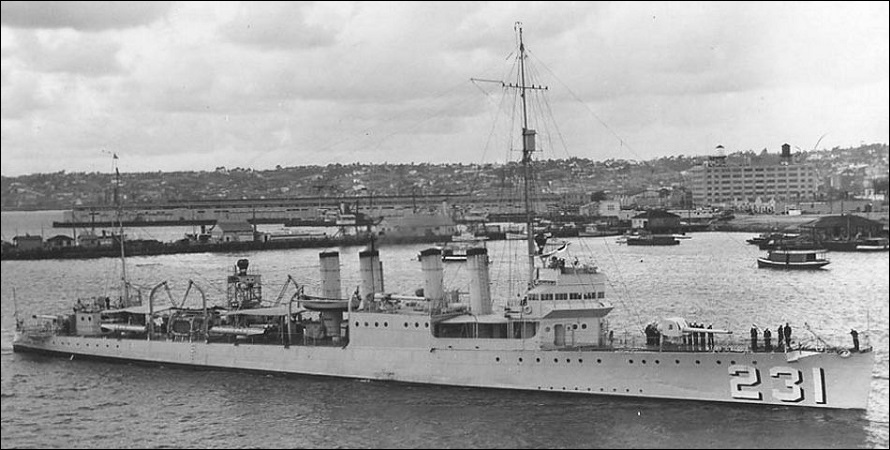
USS Hatfield
(DD-231) of the "Clemson" class as completed (Destroyer
History Foundation)
Only a handful of the four-pipers
were commissioned in time for service in World War One and
many were relegated to reserve status immediately after
completion. Some were scrapped under the terms of the London
Naval Treaty (1930), which restricted total tonnage in most
classes of warship. Others were disposed of because of the
rapid deterioration of their Yarrow boilers. Even so,
sufficient four-pipers remained to more than meet the needs
of the peacetime fleet, and it was not until 1933 that
Congress was willing to authorize new destroyers. By 1940,
93 four-pipers had been discarded with an additional twelve
lost in accidents, and 169 remained in service or in
reserve.
Being available in such large
numbers, the four-pipers were considered suitable for
conversion to other roles. In 1939 USS Manley (DD-274)
of the "Caldwell" class became the prototype fast transport
(APD-1). Her TT were removed and replaced by cranes and
davits to handle four small landing craft, and her
superstructure was enlarged to accommodate 140 troops.
Ultimately 32 four-pipers were so converted. They proved
extremely useful in the Pacific during World War Two and saw
arduous service. Wartime APD armament was 3 x 3in/50
dual-purpose guns, 2 x 40mm Bofors AA guns (twin), 4 or 5 x
20mm AA, 2 x DC racks and 2 x DC throwers.
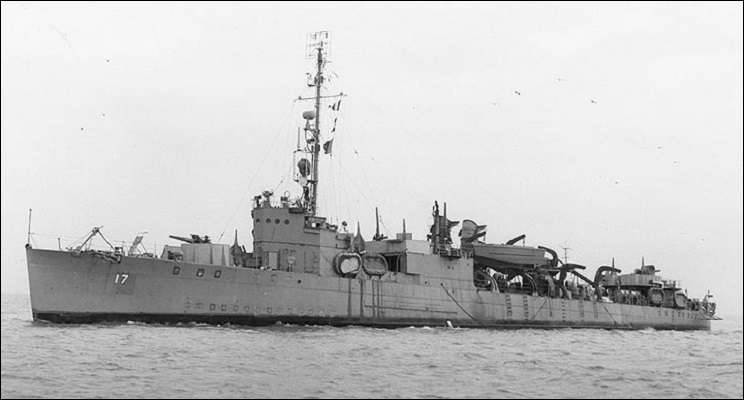
USS Crosby (ADP-17;
formerly DD-164) of the Wickes Class after conversion to a
fast transport in 1943 (Naval Heritage & History Command)
Other four-pipers were converted
into light minelayers (DM; 8 units), high-speed minesweepers
(DMS; 18 units) or light seaplane tenders (AVP; 14 units).
For all these conversions the torpedo tubes were removed and
the original 4in guns were replaced by a variable number of
3in/50 DP guns, backed up by 40mm and 20mm light AA. As with
the APD conversions, DC racks and throwers were fitted, one
boiler was removed and one or two funnels were suppressed.
Just prior to America’s entry in
World War II the Navy decided to refit another 37
four-pipers as antisubmarine escorts. They retained their
destroyer designation but like the other converted ships
they gave up a boiler and one funnel to increase fuel
stowage, reducing speed to 24–25 knots. The planned armament
was 6 x 3in/50 DP, six x 20mm AA, 2 x DC racks and 6 x DC
throwers, the latter replacing two of the four triple TT.
The last ten conversions, however, retained their original
4in guns.
In 1940 fifty of the surviving
four-pipers (20 "Clemsons," 27 "Wickes," 3 "Caldwells") were
transferred to Britain’s Royal Navy (RN) in exchange for
99-year leases on naval and air bases in British Atlantic
and Caribbean colonies. Some were never commissioned in the
RN, being cannibalized to keep others operational. Those
commissioned received names of towns and cities common to
both the US and the UK and were known as the “Town” class.
Most were refitted with a British-style bridge and conn;
typical armament was 1 x 4in forward, 1 x 12-pounder HA aft,
4 x 20mm AA, 3 x 21in TT (1 x triple mount), 2 x DC racks
and a Hedgehog antisubmarine mortar. They were not
particular popular with the RN, being considered
cramped and hard to maneuver, but they filled the gap at a
time when British-built antisubmarine escorts were in short
supply. A number of the British four-pipers were
re-transferred to the Red Navy in 1944 to cover Soviet
claims for a share of the surrendered Italian fleet; they
were returned when equivalent Italian ships were delivered.
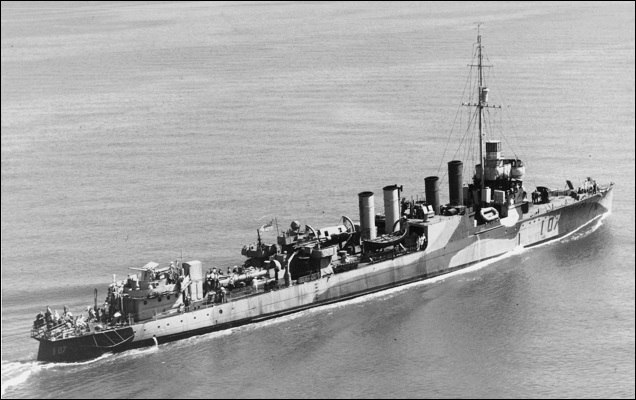
HMS Roxborough
(I07),
the former USS Foote (DD-169) after conversion to an
escort destroyer in 1940 (Imperial War Museum)
The most famous of the British four-pipers was HMS
Campbeltown (I42), formerly USS Buchanan (DD-131)
of the "Wickes" class, which served as the centerpiece
of Operation Chariot (28 March 1942). This was a joint
attack by the Royal Navy and the Combined Operations
organization, whose objective was to destroy
St. Nazaire's
Normandie dry dock
on the Atlantic coast of
occupied France, thus preventing the German Navy from basing
any large ships in the area.
Campbeltown was stripped of most of her fittings, her
appearance was altered to resemble a German torpedo boat and
her bow was packed with 4.5 tons of high explosive. The idea
was to ram the ship into the dry dock under cover of a
commando raid, with the explosives timed to detonate after
the raiding force was withdrawn. The operation was a
success, though the cost was high, and the
Normandie dry dock was put out of
operation for the rest of the war.
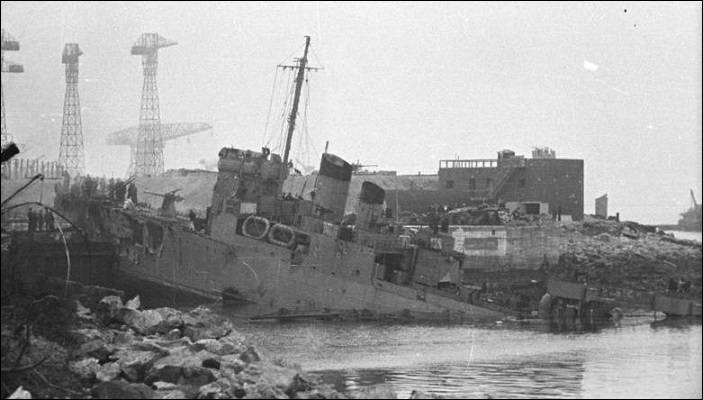
A German photo showing HMS
Campbeltown after ramming Normandie dry dock,
before the explosives aboard detonated (Bundesarchiv)
Though they were old by 1941 and
far less capable than the latest USN destroyers, the
four-pipers gave good and sometimes valiant service in a
multiplicity of roles. One, USS Reuben James
(DD-245), was the US Navy’s first World War II casualty. She
was torpedoed by the German U-552 near Iceland on 23
October 1941 while serving on escort duty. Of her crew of
143, only 44 enlisted sailors survived.
Another
four-piper, USS Ward (DD-139), fired the first shot
of the war with Japan. At about 0400 on the morning of 7
December 1941, while on patrol off the entrance to Pearl
Harbor, Ward received word of a periscope sighting
from the minesweeper USS Condor. The destroyer
immediately commenced a search. At 0637 lookouts sighted the
periscope of a submarine that appeared to be tailing a cargo
ship inbound to Pearl Harbor. Ward opened fire with
her 4in guns, scoring at least one hit, then ran in and
dropped depth charges, sinking what proved to be a Japanese
midget submarine. Ward was subsequently converted
into a fast transport, being recommissioned in February 1943
as ADP-16 and sent back to the Pacific. On 7 December 1944,
while patrolling off the Leyte (Philippines) invasion area,
she was attacked by several Japanese Kamikaze aircraft, one
of which struck her. The resulting fire could not be
controlled and after her crew was taken off, USS Ward
was sunk by gunfire from the destroyer USS O'Brien—whose
captain, Commander
William W. Outerbridge, had been the captain of the
Ward
on 7 December 1941.
At the beginning of
the war many four-pipers were still serving as fleet
destroyers. For example, thirteen were with Destroyer
Squadron (DESRON) 29 in the Asiatic Fleet, based at Manila
Bay, the Philippines. DESRON 29 had four destroyer divisions
(DESDIV), each with four destroyers, plus a squadron
flagship. Shortly after hostilities began,
the commander of the Asiatic Fleet ordered a retreat to the
Malay Barrier, and in that area DESRON 29 fought several
actions. On 20 January USS Edsall
(DESDIV 57) sank the Japanese submarine
I-124 while on escort duty near Darwin, Australia.
DESDIV 59’s four destroyers (John D. Ford,
Parrott, Paul Jones and Pope)
scored a neat success on 23 January, conducting a textbook
night torpedo attack against a Japanese invasion force off
Balikpapan. Four transports and a patrol vessel were sunk;
in return only Ford was slightly damaged. But the
Battle of the Java Sea and subsequent actions proved to be
the Asiatic Fleet’s swan song. Of the four-pipers, four were
sunk and one, Stewart, was damaged then captured by
the Japanese while in drydock. After being repaired and
rearmed, she was commissioned in the Imperial Japanese Navy
as No. 102. She survived the war and was returned to
the USN after Japan’s surrender, ultimately being expended
as a target. The eight survivors of DESRON 29 returned to
the US for conversion to escort destroyers, afterwards
serving in the Atlantic.
With the end of the war the
four-pipers passed into history. Most were decommissioned
and scrapped in 1945-47; none survive today. Manned largely
by Reserve crews from 1942 onward they had served the Navy
well in many roles, vital if not usually heroic. But the
most famous four-piper of all was one that never existed in
reality: USS Caine (DMS-22), Lieutenant Commander
Philip Francis Queeg commanding. The Caine was the
principal setting for Herman Wouk’s great novel of the US
Navy in World War II,
The Caine Mutiny.
Wouk, a Navy veteran of the war, had served aboard USS
Zane (DMS-14)
and USS Southhard
(DMS-10). Like the fictional Caine
both were
four-pipers converted into
destroyer-minesweepers. Lest we forget...
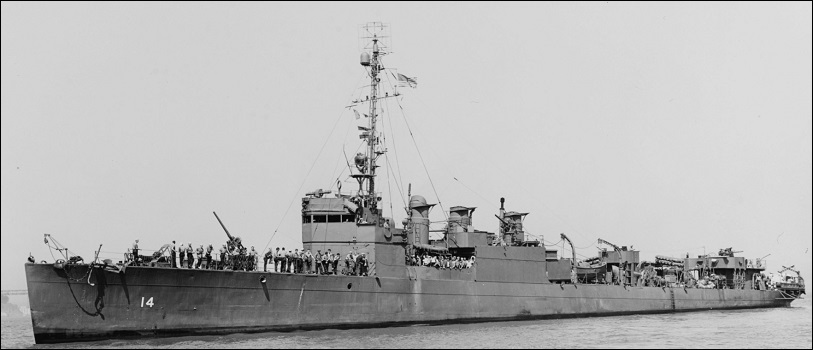
USS Zane (DMS-14),
one of the two four-pipers that served as models for the
fictional USS Caine (Naval Heritage & History
Command)
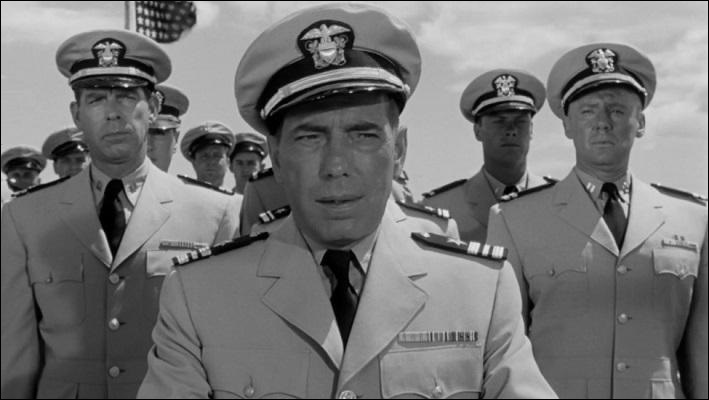
The officers of the USS
Caine (DMS-22), from the 1954 Columbia Productions film
of Herman Wouk's novel. From left to right: Fred MacMurray as
Lieutenant Keefer, Humphrey Bogart as Captain Queeg, Robert
Francis as Ensign Keith and Van Johnson as Lieutenant Maryk.
